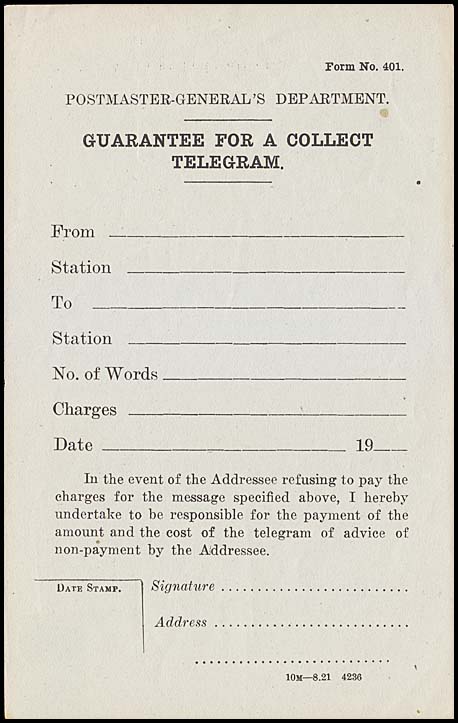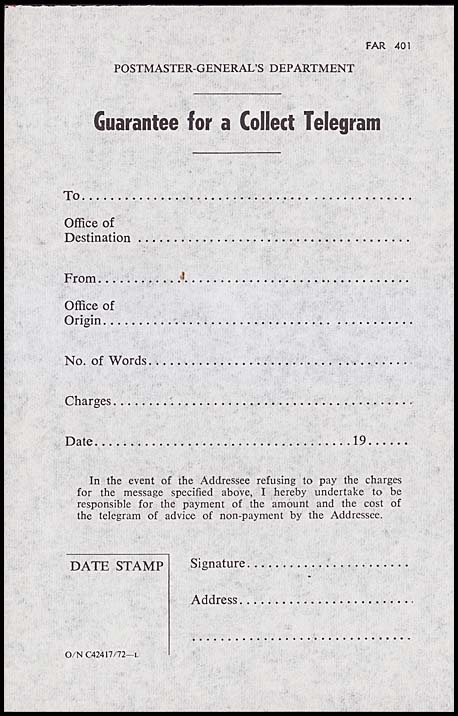Collect telegrams and the Instructional annotation.
- Australia 1901-1988
- New South Wales
- Queensland
- South Australia
- Tasmania
- Victoria
- Western Australia
- International
- Special aspects
Collect telegrams allowed a sender of a telegram to transfer payment of transmission charges to the receiver of a telegram. They were complementary to Reply-Paid telegrams which required the sender of an original telegram to pre-pay the costs of a reply as well as the cost of the original telegram.
Details of Collect Telegrams are summarised in the following sections:
- Early Colonial use of COLLECT telegrams;
New South Wales;
Queensland;
South Australia;
Tasmania;
Victoria;
Western Australia.
- Australian post-Federation Regulations;
- Examples of Post Federation COLLECT telegrams;
- Dockets to guarantee payment;
- COLLECT cables - see India-Australia 1948 example.
1. Australian (post-Federation) Regulations.
The Federal Post and Telegraph Act of 1901 contained the following:
"Collect telegrams will now be accepted within the Commonwealth, but only when the sender is known to the officer in charge and upon his signing a guarantee that should the addressee refuse to pay the cost, the sender of the telegram will pay the amount together with telegram of advice of non-payment by the addressee".
The Post and Telegraph Guide of June 1922 presented the Regulation outlining the use of this type of telegram as follows:
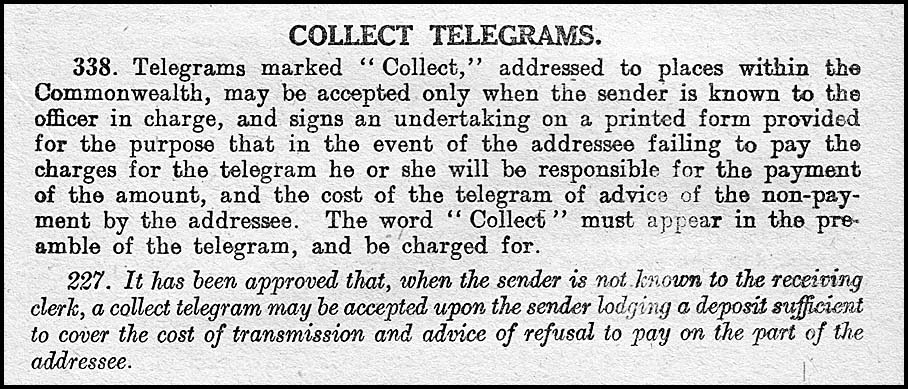 |
In October 1949, the Postmaster-General announced that a "Collect Telegram" service was to be introduced on 1 November:
"This collect service will permit the lodgement, without prepayment, of messages for transmission to and from Australia and places in the ".Territory of Papua - New Guinea.
The amount involved in each case will be collected from the person to whom the telegram is addressed.
In the case of an addressee refusing to meet the charges, the sender must meet the cost of both the telegram and charges for advice of non-payment".
The official description changed little in the years after 1922. For example, the 1952 Post Office Guide had almost exactly the same wording but the same intent in Part II Commonwealth Telegrams, paragraph 60. Perhaps the main change was the replacement of "he or she" in line 5 with "he"!!
3. Examples of post Federation COLLECT telegrams.
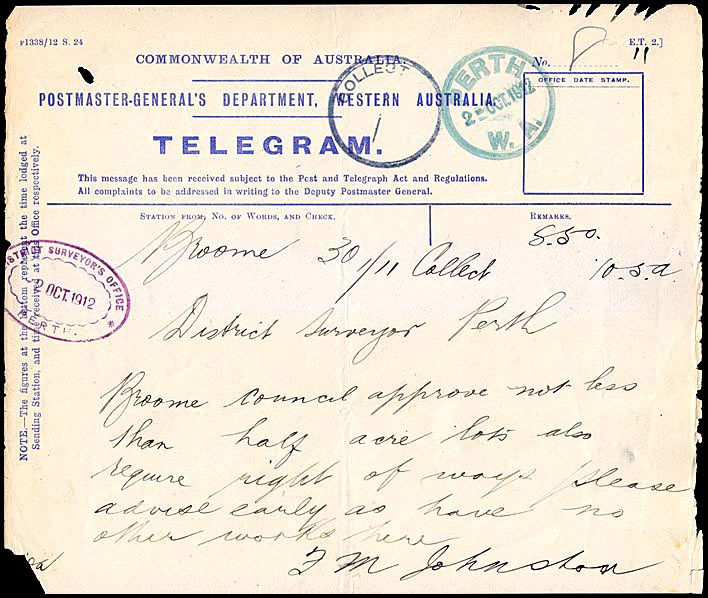 |
WI-DO-5A.
Broome to Perth. Has annotation 1/11 Collect meaning that the District Surveyors Board had to pay 1/11 to receive the telegram. Has a rare COLLECT hand stamp - only recorded example. |
Collect telegrams have been used in many situations:
- the Adelaide News of 28 February 1942 reported that: "Ironworkers at an Ashfield annex of Amalgamated Wireless (Australasia) Limited who went on strike over the dismissal of a union delegate and that the position was aggravated because the delegate had been dismissed by a telegram on which he had to pay 2/6";
- STOP "COLLECT" TELEGRAM FRAUD.
CANBERRA, 30 November 1939.
"Procedure will be adopted by the Post Office in all States to protect the recipients of "collect" telegrams from the operations of racecourse "urgers." The Postmaster -General (Mr. Harrison) announced this action to-day to combat the operations of "urgers" who had been sending Collect telegrams containing racing tips to people, and later demanding a cash percentage if their horses won. In future, senders of "Collect" telegrams will have to deposit a sum equal to the cost of the telegram, and an additional amount to pay for a reply if the recipient refuses acceptance. The recipient will be allowed to open and retain the telegram without meeting the "Collect" charge. Mr. Harrison said he deplored the fact that the services of his department had been used by "urgers" to further their own ends. He would introduce some other form of protection if the present action was inadequate". (carried in several newspapers).
- "By arrangement with the Postmaster-General, district weather forecasts designed to meet the requirements of the main industries in each particular district are telegraphed daily at noon to all telegraph offices. Forecasts when received at country post offices are posted on the office notice board for public information. A district forecast will be made available by the postmaster to any person on telephoned inquiry or by "collect" telegram in case of a telegraphed request" (Armidale Express 29 November 1941).
4. Dockets to guarantee payment.
In October 1894, the NSW Gazette announced the restoration of the "collect telegram" system. "People who are known are required to sign and pay in default; also the cost of the message notifying default".
The forms used by the sender to guarantee the cost of the telegram varied little. Two examples follow:
Schedule numbers known: 10m - 8.21 4236; |
Schedule numbers known: Sch. C.6687 - 12/51; |
The monies collected for Collect telegrams had to be accounted and special forms, shown below, were used.
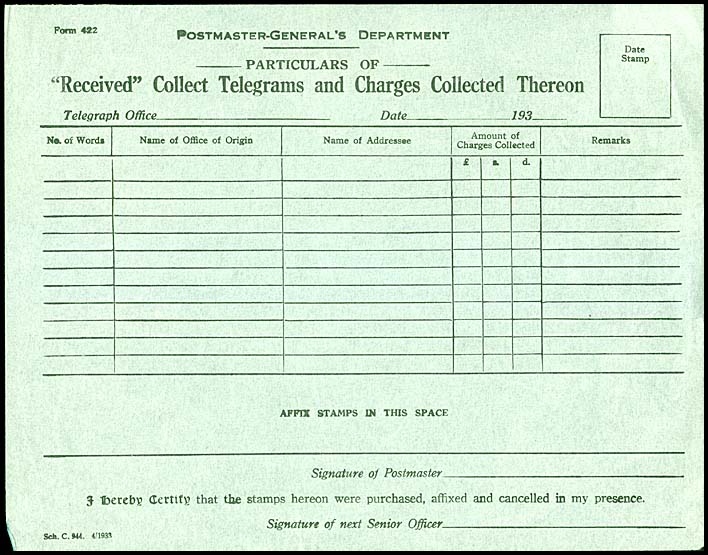 Printed in April 1933 (Schedule number Sch. C. 944 4/1933). |
Acquittal form to be forwarded to the Head Office of the PMG in each State.
A duplicate - with the same heading but no boxes - was placed underneath with carbon paper between to enable a copy to be made easily (on the same principle as that shown below for the 1942 form). Printed over many years in almost the same format as shown. |
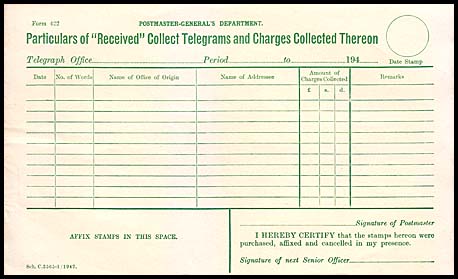 Printed in 1942 (Schedule number Sch. C. 3565-1/1942). The two parts were combined and carbon paper placed between so as to make a copy of the details. |
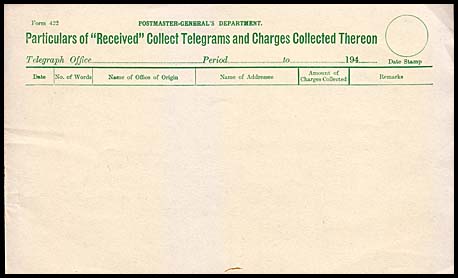 |
Collect telegrams gradually ceased when telephones became widespread and it was possible and easy to call Telephone Offices established to receive such requests and charge costs to a telephone account. Details were then recorded on Phonogram forms.
